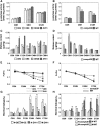The OsMYB30 Transcription Factor Suppresses Cold Tolerance by Interacting with a JAZ Protein and Suppressing β-Amylase Expression
- PMID: 28062835
- PMCID: PMC5291022
- DOI: 10.1104/pp.16.01725
The OsMYB30 Transcription Factor Suppresses Cold Tolerance by Interacting with a JAZ Protein and Suppressing β-Amylase Expression
Abstract
Cold stress is one of the major limiting factors for rice (Oryza sativa) productivity. Several MYB transcriptional factors have been reported as important regulators in the cold stress response, but the molecular mechanisms are largely unknown. In this study, we characterized a cold-responsive R2R3-type MYB gene, OsMYB30, for its regulatory function in cold tolerance in rice. Functional analysis revealed that overexpression of OsMYB30 in rice resulted in increased cold sensitivity, while the osmyb30 knockout mutant showed increased cold tolerance. Microarray and quantitative real-time polymerase chain reaction analyses revealed that a few β-amylase (BMY) genes were down-regulated by OsMYB30. The BMY activity and maltose content, which were decreased and increased in the OsMYB30 overexpression and osmyb30 knockout mutant, respectively, were correlated with the expression patterns of the BMY genes. OsMYB30 was shown to bind to the promoters of the BMY genes. These results suggested that OsMYB30 exhibited a regulatory effect on the breakdown of starch through the regulation of the BMY genes. In addition, application of maltose had a protective effect for cell membranes under cold stress conditions. Furthermore, we identified an OsMYB30-interacting protein, OsJAZ9, that had a significant effect in suppressing the transcriptional activation of OsMYB30 and in the repression of BMY genes mediated by OsMYB30. These results together suggested that OsMYB30 might be a novel regulator of cold tolerance through the negative regulation of the BMY genes by interacting with OsJAZ9 to fine-tune the starch breakdown and the content of maltose, which might contribute to the cold tolerance as a compatible solute.
© 2017 American Society of Plant Biologists. All Rights Reserved.
Figures








Similar articles
-
PtrBAM1, a β-amylase-coding gene of Poncirus trifoliata, is a CBF regulon member with function in cold tolerance by modulating soluble sugar levels.Plant Cell Environ. 2014 Dec;37(12):2754-67. doi: 10.1111/pce.12384. Epub 2014 Jul 9. Plant Cell Environ. 2014. PMID: 24905016
-
Rice NAC transcription factor ONAC095 plays opposite roles in drought and cold stress tolerance.BMC Plant Biol. 2016 Sep 20;16(1):203. doi: 10.1186/s12870-016-0897-y. BMC Plant Biol. 2016. PMID: 27646344 Free PMC article.
-
RNA interference of Arabidopsis beta-amylase8 prevents maltose accumulation upon cold shock and increases sensitivity of PSII photochemical efficiency to freezing stress.Plant J. 2005 Dec;44(5):730-43. doi: 10.1111/j.1365-313X.2005.02565.x. Plant J. 2005. PMID: 16297066
-
Regulation of β-amylase synthesis: a brief overview.Mol Biol Rep. 2021 Sep;48(9):6503-6511. doi: 10.1007/s11033-021-06613-5. Epub 2021 Aug 11. Mol Biol Rep. 2021. PMID: 34379288 Review.
-
The importance of maltose in transitory starch breakdown.Plant Cell Environ. 2006 Mar;29(3):353-66. doi: 10.1111/j.1365-3040.2005.01480.x. Plant Cell Environ. 2006. PMID: 17080591 Review.
Cited by
-
The AaCBF4-AaBAM3.1 module enhances freezing tolerance of kiwifruit (Actinidia arguta).Hortic Res. 2021 May 1;8(1):97. doi: 10.1038/s41438-021-00530-1. Hortic Res. 2021. PMID: 33931620 Free PMC article.
-
A Brassica napus Reductase Gene Dissected by Associative Transcriptomics Enhances Plant Adaption to Freezing Stress.Front Plant Sci. 2020 Jun 26;11:971. doi: 10.3389/fpls.2020.00971. eCollection 2020. Front Plant Sci. 2020. PMID: 32676095 Free PMC article.
-
Overexpressing heat-shock protein OsHSP50.2 improves drought tolerance in rice.Plant Cell Rep. 2018 Nov;37(11):1585-1595. doi: 10.1007/s00299-018-2331-4. Epub 2018 Aug 11. Plant Cell Rep. 2018. PMID: 30099612
-
Comparative Proteomics Combined with Morphophysiological Analysis Revealed Chilling Response Patterns in Two Contrasting Maize Genotypes.Cells. 2022 Apr 13;11(8):1321. doi: 10.3390/cells11081321. Cells. 2022. PMID: 35456000 Free PMC article.
-
Analysis of Global Methylome and Gene Expression during Carbon Reserve Mobilization in Stems under Soil Drying.Plant Physiol. 2020 Aug;183(4):1809-1824. doi: 10.1104/pp.20.00141. Epub 2020 Jun 8. Plant Physiol. 2020. PMID: 32513834 Free PMC article.
References
-
- Agarwal M, Hao Y, Kapoor A, Dong CH, Fujii H, Zheng X, Zhu JK (2006) A R2R3 type MYB transcription factor is involved in the cold regulation of CBF genes and in acquired freezing tolerance. J Biol Chem 281: 37636–37645 - PubMed
-
- Bai Y, Meng Y, Huang D, Qi Y, Chen M (2011) Origin and evolutionary analysis of the plant-specific TIFY transcription factor family. Genomics 98: 128–136 - PubMed
-
- Baker NR, Rosenqvist E (2004) Applications of chlorophyll fluorescence can improve crop production strategies: an examination of future possibilities. J Exp Bot 55: 1607–1621 - PubMed
-
- Chini A, Fonseca S, Fernández G, Adie B, Chico JM, Lorenzo O, García-Casado G, López-Vidriero I, Lozano FM, Ponce MR, et al. (2007) The JAZ family of repressors is the missing link in jasmonate signalling. Nature 448: 666–671 - PubMed
-
- Chinnusamy V, Zhu J, Zhu JK (2007) Cold stress regulation of gene expression in plants. Trends Plant Sci 12: 444–451 - PubMed
Publication types
MeSH terms
Substances
LinkOut - more resources
Full Text Sources
Other Literature Sources
Molecular Biology Databases

